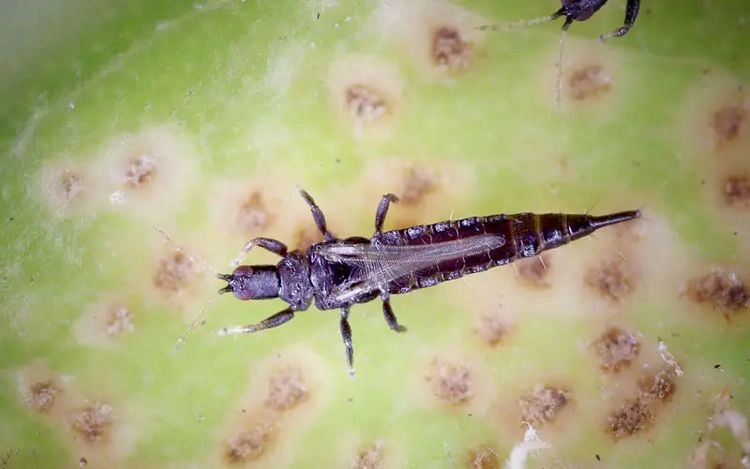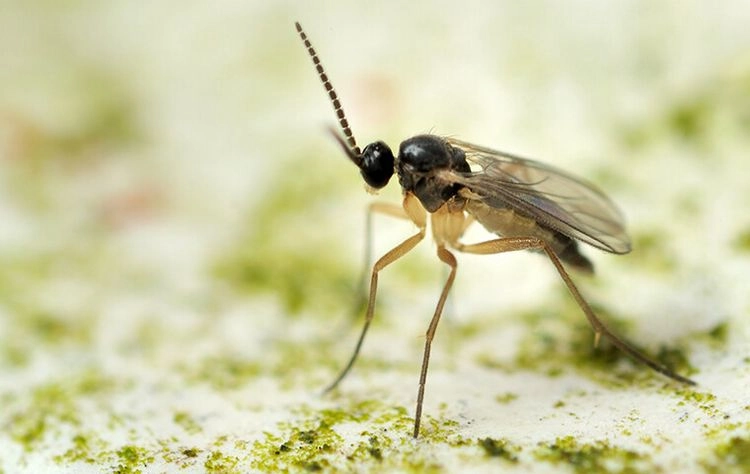Growing tomatoes at home is notoriously difficult, but when you succeed, they’re one of the most delicious garden crops—there’s no denying the insane taste of homegrown tomatoes. Unfortunately, these plants are susceptible to many pests, so you may have to fight off multiple attacks before you can eat them. Healthy soil, constant watering, and good nutrition ensure robust plants that are better able to resist pests and diseases as they develop. In the following article you will learn more about how to combat blackflies on tomatoes as they are some of the most common tomato pests!
Recognizing small, black flies on tomatoes
Do you often see small, black flies crawling around on the potting soil of your tomatoes? Fungus gnats are the most likely pests in this case. However, your plants could also be infested with thrips — these are the flies seen on the leaves of your tomatoes.
detect thrips

Small, thin insects called thrips are best seen with a handheld magnifying glass. These pests are so tiny that you can hardly see them with the naked eye. Thrips can also be found on the shoot tips, fruit and underside of the leaves. They may be tiny, but they cause significant damage to plants. They damage plants by transmitting infections through the sap they ingest.

Although thrips have a short lifespan, they can produce up to 15 generations in a single growing season, creating significant problems for plant owners. Most thrips species can overwinter in garden waste, where they will lay their eggs in the spring. The eggs hatch after about 5 days and the feeding frenzy lasts up to 3 weeks, which is enough time to destroy the vitality of otherwise hardy tomato plants. Because of their feeding habits, thrips can cause stunted plant development, flower deformities, and white or silvery spots on developing leaves.
How to fight black flies

- Check the plants and keep an eye on them
All plants brought into the garden should be inspected for thrips or thrips damage. If you spot pests, spray them with a powerful, all-encompassing stream of water.
- Eliminate grass and weeds
In order to get rid of thrips, it is important to eliminate their intermediate hosts, i.e. remove weeds and grass from the garden. After harvest, collect any remaining waste in the garden.
- Using beneficial insects as a biological method
Use beneficial insects to control and eradicate all stages of this pest – tiny predatory mites, ladybugs (particularly effective in greenhouses) and lacewings work best. For best results, spray water or otherwise kill an extreme infestation before releasing the natural predators.
- Use mulch that reflects light
Using reflective mulch can deter thrips by blocking their visual cues of the plants’ location. While this strategy might work on young, smaller plants, its effectiveness often decreases as plants age. Small gardens can also benefit from using aluminum foil.
Neem oil is non-toxic and efficient at eradicating heavy infestations (without killing the environmentally valuable insects).
Black flies on tomatoes – fungus gnats

While adult fungus gnats are usually just a nuisance, their burrowing larvae can cause significant damage to young plants and seedlings by feeding on the delicate new roots. The infestation places an additional burden on young plants as they have difficulty establishing themselves due to root feeding. Damage to a plant is usually first manifested by wilting, followed by the death of the plant. If you find very young plants becoming limp or seeming to be rotting in place, fungus gnats are likely to blame.

Controlling fungus gnat populations requires knowing the insect life cycle and their main feeding times. Fungus gnats lay their eggs in cracks in the ground. Within six days of hatching, the eggs turn into larvae that feed on the roots of the plants. After two weeks, they feed on the roots of plants, pupate in the soil, and hatch as adults about a week later to start the cycle all over again. Fungus gnats have a high reproductive rate because they produce mostly female offspring. A single female can lay around 100-300 eggs. That is why this pest is so dangerous for your tomato plants.
Get rid of fungus gnats successfully

Yellow boards coated with glue serve as bait in these traps. They are most effective when cut into small squares and either placed on the ground or attached to skewers at a slight angle above the ground. The adult fungus gnats land on the board and get stuck in the glue. Use the yellow panels instead of the blue ones, as fungus gnats are attracted to the color yellow. Both are available at any gardening store or even online.
- Make your own vinegar trap
Mix equal parts water and vinegar in a shallow dish (a can of tuna works great for this). The liquid must be at least 1.5 cm deep. Add some dish soap and whisk the mixture. The trap should be placed either near the root system of the plant or preferably in the pot on the ground. Check the trap every few days and give it a fresh dose of vinegar and water.
